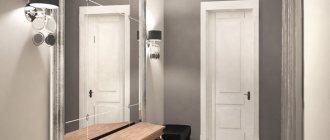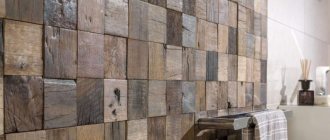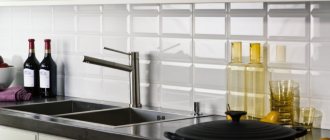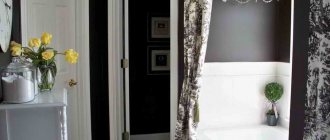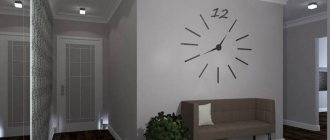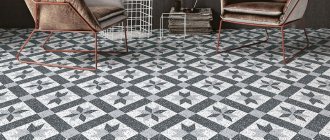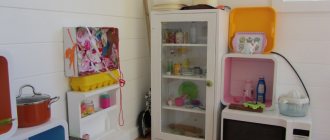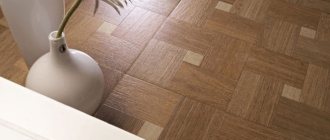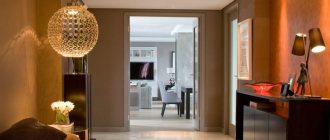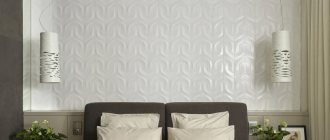Types of bathroom tiles
Manufacturers offer a wide range of tiles from a wide variety of materials for the bathroom.
They differ from each other in the following parameters:
- size;
- shape;
- material;
- functional purpose.
Solid surfaces are laid out from large rectangles, sometimes they already have a pattern laid down by the manufacturer. Small ones are used to create mosaics. Since such tiles are often thin, they are used to decorate walls.
Tiles of various shapes are also used to create patterns. These can be rectangular figures, polygons, in addition, products in the form of rounded sections of wild stone.
By type of material, bathroom tiles, photos of which can be seen in various catalogs, are:
- ceramic;
- porcelain stoneware;
- clinker
For mosaics, classic ceramic squares with a glazed surface are most often used. Porcelain tiles and clinker are more often used as flooring because these materials are highly durable and highly resistant to abrasion.
Small modern bathroom
A small bathroom is, unfortunately, the reality of many Russian apartments. But this does not mean that it will not be possible to embody fashionable design ideas. Of course, in a large room it is much easier to come up with solutions, but you can also bring fresh ideas to a small bath.
- For a small bathroom, small tiles (square or rectangular) are perfect. You can even choose a tile that is large but displays small cells.
Small bathroom design
- The same goes for floor tiles. Don't choose oversized tiles for a small bathroom. It is advisable that the size of the tiles be no more than 30 cm in width and length.
- Plain tiles without patterns for a small bathroom are the choice of designers in 2020. You can play up its simplicity with various accessories.
Advice. Don't forget about places to store household chemicals and other small items. Sliding bath screens or compact cabinets are perfect for this.
- Avoid baths and showers. Nowadays, a shower that is fenced off with a glass barrier is in fashion. This technique will not only give an external airiness to the room, but will look very modern.
- Tile and furniture in white, beige and any other light shade will help to visually enlarge a small room.
- Install a large mirror. This is not only a necessary piece of furniture, but also a well-known design technique that will help expand the space of the room.
Bathroom design in gray tones
A bathroom, regardless of its size, can be decorated in a modern, fashionable style. To do this, it is necessary to take into account the main trends of the season: the multifunctionality of the room, the use of natural materials and light colors for decoration. And don’t forget about the details, which play an important role.
Possible mistakes in bathroom design: video
Modern bathroom design: photo
Ceramic tiles for bathroom
This is a classic finishing material, known since ancient times. Tiles are most often produced in the form of rectangles. Its front side is covered with glaze, the back has a grooved surface. Thanks to this, high-quality adhesion of the tiles to the wall surface is achieved.
Tiles are made from pressed clay with the addition of sand and various natural materials. They improve the quality of the material, improve its mechanical properties, and extend the service life of products.
During the production process, raw materials are pressed, shaped and passed through a kiln. Then a pattern or dye is applied to the surface of the product. And on top of it is a layer of glaze, which is fixed by heat treatment.
This coating prevents water from entering the base material and prevents moisture from destroying the ceramics.
The tiles are placed both on the walls and on the floor. You can use it to lay out a mosaic pattern or create a decorative panel. Some manufacturers produce tiles from which the design is laid out. Recently, images with a 3D effect, that is, creating the illusion of volume, have become popular.
Many people decorate their bathroom with majolica. This is the name for the technique of applying an image to the surface of a tile, which has a characteristic pattern and is distinguished by a special blue color.
Majolica is created by hand, so this material is more expensive than other types of ceramic coating. But due to the specifics of production, each product is unique, so no one will have a second bathroom like this. As a complement to the main pattern, mosaics are created from small tiles.
Tile is used in almost all styles of home decoration. A variety of colors and patterns allows you to fit it into any design.
Types and features
Perhaps the most famous type of tile for all of us, on which drawings are applied, is majolica. However, not everyone knows that it has its own varieties. Each of them has certain key features and a history of origin. Moreover, they are used in different areas, and the purchase can cost different amounts of money.
In Italian
This type of majolica was created in Egypt. This is probably why it is characterized by increased resistance to temperature. Around the 11th century, it was brought to Italy, where the first experiments on the material began. As a result, modern Italian majolica is made in a variety of colors and complemented with opaque glazes. When the patterns and designs are applied, it is covered with this very glaze, after which the products are sent to the oven.
In Dutch
In Holland, tile production began in the 16th century, and the period of active development of tile making began in the 18th century. At that time, over thirty enterprises operated in the country. The main feature of this majolica is constant experimentation with it. Various designs, techniques for applying them, colors, clay composition, and so on are used. Dutch majolica is easy to distinguish from others due to the love of manufacturers to play with contrasts. So, a white base can be combined with bright purple, bright red geometric shapes. Some collections depict people, animals and plants, but they are not so popular.
In Russian
Such majolica also exists. In many ways, it repeats the production method in Holland of the 17th century. But Russian majolica still has its own peculiarity in our time - the designs on it are modern, many collections are made with female silhouettes or even logos of leading automakers. Classic collections are offered with designs of flowers, ornaments and everyday objects.
For bathroom
Photo of tiles with a pattern
If you are planning to renovate your bathroom, then ceramic tiles with a pattern should have their own specific characteristics, or rather motifs.
Most often you can find interiors with themed water images, that is, with the inhabitants of the deep sea, shells, algae, and so on. Another popular destination is ships or waterfalls. For walls, these options are perfect.
As for the floor, here you can concentrate on the image of the bottom of the sea, a sandy beach. Although topics far from water are also quite suitable.
For kitchen
To prevent your kitchen from looking boring, try decorating it with tiles with images.
In this case, the themes of everyday life, food, and kitchen utensils are suitable. For example, drawings with fruits, vegetables, beautiful dishes. Many people also love pictures with flowers and ornaments. And if you want variety, you don’t want to stick to a purely “kitchen” theme, then “let” animals and butterflies into the kitchen.
Essentially, there is room for creativity in front of you. No one limits you in choosing tiles on which all kinds of images are printed.
Just remember that drawings can only be used on one of the surfaces - wall, ceiling or floor. The remaining two should be done with single-color tiles or tiles of different, but very similar shades.
Porcelain tiles in the bathroom
This material has become an alternative to classic ceramic tiles for bathrooms. To make it, crushed natural ingredients are used. As a result of production processes, a mass is formed that has a very low ability to absorb moisture. This feature makes porcelain tiles indispensable as bathroom flooring. After all, it is the floor that receives the bulk of water when bathing or washing in the shower.
The method for making such tiles is similar to that described above. But pressing is done under higher pressure, and firing is done at a higher temperature.
Heating creates a strong structure similar to glass. Thanks to such a high density, porcelain stoneware bathroom tiles have high resistance to abrasion and other mechanical stress, better withstand temperature changes, and are stronger and more durable than glazed ceramics.
Such products are produced in the form of squares and rectangles, as well as irregular geometric shapes. Some manufacturers make tiles in the shape of sections of natural stone. They are in demand among those who create interiors in country or ethnic style.
Porcelain stoneware coatings are not used for mosaics, because manufacturers most often give the products a uniform surface.
Such material is often not covered with a layer of glaze. This improves the grip of shoes or feet on the surface of the tiles, which protects people from accidental falls on wet floors. Porcelain stoneware tiles intended for wall coverings are polished. The cost of such products is much higher than that of unpolished ones. But this disadvantage is compensated by the aesthetic appeal of the surface.
The advantages of the material also include its high density and uniform structure. This protects porcelain tiles from cracking, which occurs after a while, especially in flooring.
Surface quality
In most cases, designers recommend choosing tiles with a matte or semi-matte surface, as they look more attractive in the interior.
Remember that the basis of a modern interior is naturalness and it is matte surfaces that create a natural, cozy and comfortable design.
If we are talking about tiles in the bathroom, then gloss is inappropriate here for several reasons. On the shiny, smooth surface of the walls, stains from splashing water will be visible.
Glossy floor tiles can also cause falls as they are very slippery, especially when wet.
Clinker tiles
Clinker is used less often in bathrooms, because this material is more suitable for external cladding. For production, special grades of clay are used, which is pressed under high pressure before heat treatment. This will remove excess air and water from the material, causing the bathroom tiles to become denser.
The properties for which clinker is famous: strength, durability, wear resistance, are achieved by firing at very high temperatures.
After this treatment, the clinker surface does not absorb moisture, which makes it an ideal material for cladding floors and walls in bathrooms.
In addition, this material is impervious to chemicals, so any contaminant susceptible to chemical reagents can be removed from the surface of clinker coatings.
Mosaics made from clinker tiles will give the bathroom a cozy look. Strength and reliability guarantee such a surface for many years of service. This type of material is used in design in high-tech, modern, country and ethno styles.
Technical characteristics of tiles, nuances of choice
After studying the basic principles of distributing tiles on floors and walls, choosing this material becomes much easier. Cutting waste is reduced, there are no scraps/stubs in the interiors, and the labor intensity of finishing work is reduced.
Marking the room for tiling
For your information! Not every bathroom tile whose photo design suits you is suitable for decorating your bathrooms.
Secrets of choice
Incorrect selection of tiles may not allow you to complete the finishing of the bathroom. Moreover, this point is revealed as the work progresses. Therefore, the property owner should pay attention not only to what bathroom tile photo design has, but also to the following nuances:
- manufacturer - preferably only foreign companies, which will avoid unequal colors, sizes, geometry even within the same batch;
Famous tile manufacturers
- collection - represents a ready-made solution from several components (floor + decor + borders + light and dark background), matte for the floor, gloss for the walls;
Bathroom tile collection
- cut – cutting decors is prohibited; background/floor tiles can be cut in any direction.
Helpful advice! In standard and large-sized apartments, it is better not to use curbs. They are designed for bathrooms from 15 square meters. The main value of the border is the creation of a single belt; in practice, it is interrupted by doorways and plumbing; these elements are lost and partially covered by objects .
Laying principles
The main nuances of finishing work when using porcelain stoneware and tiles are:
- Installation methods:
- classic - the axis of the center of the wall coincides with the center of the middle tile, which is glued first, the undercuts in the corners are guaranteed to be of a large format, the consumption of tiles increases slightly, but the design is perfect;
Classic layout
- from the corner - the row is filled from the corner, the size of the tiles on the opposite wall is unpredictable, a narrow strip sharply reduces the aesthetics of the perception of the interior, but with a width of more than half, such a scheme is quite appropriate;
Unsuccessful layout from the corner
- from the center - a whole tile is laid from the middle of the wall to the corners, in which two cuts are made.
Centered layout used in special cases
The “from the corner” layout is not recommended; the remaining two are used depending on the specific configuration of the bathroom and the boxes inside it.
- Layout methods:
There are a huge variety of tile layout options. All of them differ in the degree of complexity and skills of the master, as well as the achieved effect.
Basic tile layout options
Here are some examples of bathroom interiors with different tile layouts:
Bathroom interior with horizontal layout
Vertical tile layout
Various layout combination options
- Communications:
When lining secret inspection hatches, a layout from the center with two side cuts in the corners is used. This option is much nicer than a hatch without lining.
Design of the inspection hatch
- GCR systems:
Drywall can be used to artificially build up boxes and walls to adjust the dimensions of load-bearing structures for entire horizontal rows without undercutting. This technique is absolutely economically justified even in small baths, bathrooms in Khrushchev and Brezhnev buildings. The loss of useful working space of 0.2 - 0.5 square meters with an increase in the quality of the interior is completely justified for operation.
GCR boxes can be arranged so that entire rows of tiles fit on them
- Floor tiles:
The classic layout scheme with minor additions is often used. In bathrooms with shower stalls, the entire floor surface is tiled from the center. If the room has a bathtub, the room is divided into two zones by a screen below it, each space filled from its own center line.
Distribution of porcelain floor tiles
The amount of trimming is doubled, but within each zone the quality of distribution of large-format cladding is maintained. It is worth remembering that floor tiles should be laid so that the places where the tiles are cut fall on the places that will be filled with furniture.
Recommendations for laying floor tiles
Helpful advice! The main mistake of home craftsmen and professional tilers is the vertical orientation of wall tiles. If you lay it horizontally, the number of narrow cuts will be reduced and the dimensions of the room will visually increase.
Related article:
Floor tiles for the kitchen: photos and prices. A separate publication presents a photo selection of interesting tiles with selection tips and prices.
Marking of ceramic tiles
The choice of finishing material is made not only on the basis of personal impression. Manufacturers provide packaging with special symbols that inform the buyer about the properties of the product.
The main symbols are the following:
- footprint - tiles are intended for laying on the floor;
- palm print - the tile is a wall tile;
- snowflake - speaks of frost resistance;
- a shoe on an inclined surface is an indicator of friction when sliding;
- diamond - the hardness of the product;
- circular saw - abrasion resistance;
- chemical flask - resistance to chemicals;
- squares of different colors - products in packaging may differ in shades.
In addition, the recommended place of use of the products (community centers, industrial premises, housing) is indicated on the package. If metals and other substances are added to the material during manufacturing, the symbol of an element from the periodic table is added to the marking.
The weight, total area of ceramic tiles and the number of units in one pack are also marked on the packaging.
In addition to these special symbols, manufacturers also use generally accepted international signs:
- glass (fragile objects);
- open umbrella (keep away from moisture);
- arrows (indicate where the top of the package is).
Knowing these symbols, the buyer will protect himself from wasting money and will buy the product he needs.
Light or dark?
Light finishing materials for walls and floors can visually increase the area of the room. If this is not necessary, then you can safely choose darker tones.
With the help of proper color combinations, you can divide the room into zones. When choosing a color, remember that naturalness and naturalness are in fashion and this also applies to interior design.
